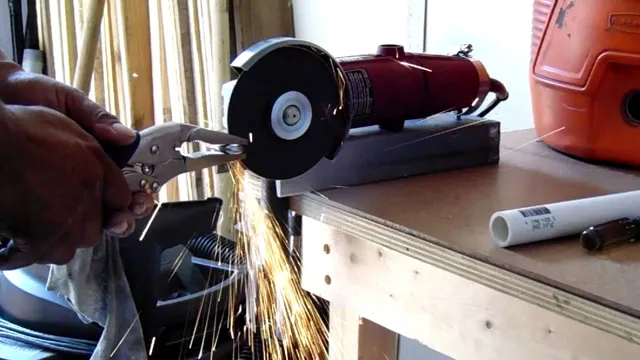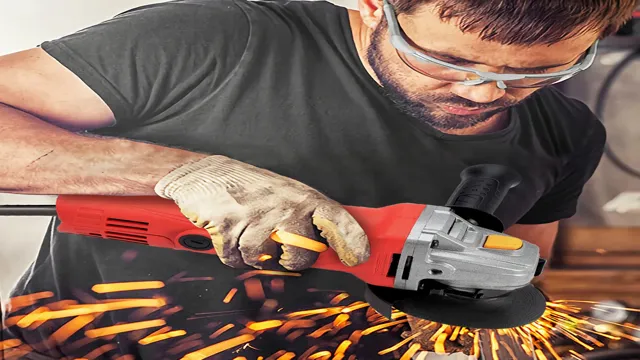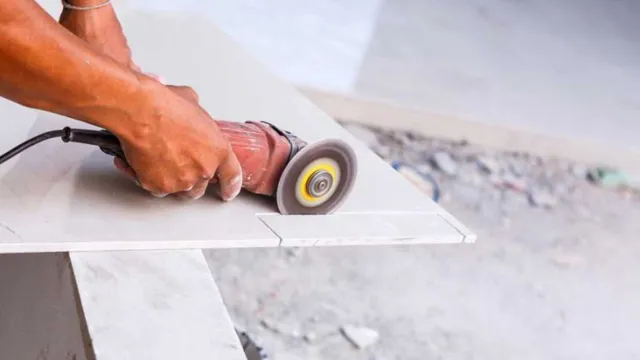Can You Use an Angle Grinder as a Polisher? A Comprehensive Guide to Tool Compatibility

If you’re a DIY enthusiast or a professional handyman, you know the value of having a versatile tool in your arsenal. Angle grinders are incredibly versatile and useful for a range of tasks. One task that you may not have considered doing with an angle grinder is polishing.
However, it is entirely doable with the right technique and attachments. If you want to restore a rusty metal object or give a shiny finish to a piece of stone, glass, or concrete, an angle grinder can be an excellent alternative to a traditional polisher. The good news is that using an angle grinder as a polisher can save you time, money, and effort.
In fact, an angle grinder is faster and more efficient than a polisher because it can remove rough patches of a material faster and sand deeper into surfaces. While using an angle grinder as a polisher may seem daunting to beginners, it’s a fairly simple process once you get the hang of it. All you need is the right polishing disk or attachment, knowledge of the proper technique, and a little bit of patience.
In this blog, we’ll discuss everything you need to know about using an angle grinder as a polisher, the materials you can work with, the different types of polishing disks, and some tips and tricks to get the best results. So, get ready to learn how to turn your angle grinder into a powerful polisher that can help you tackle all kinds of DIY projects with ease. Whether you’re looking to make your car or bike shine or smoothing out rough concrete edges, an angle grinder can be your new go-to tool.
With a bit of practice, you’ll soon be achieving impeccable finishes that you never thought were possible with an angle grinder.
Understanding the Basics of Angle Grinders
Angle grinders are handy power tools that can be used for various tasks, and one of the most common questions people ask is whether they can use an angle grinder as a polisher. The answer is yes! Angle grinders can be used for polishing, but you need to attach a polishing pad or disk to the tool. However, keep in mind that polishing with an angle grinder requires some skill and practice, so it’s crucial to take some time to learn the proper technique.
Polishers and angle grinders have significant differences in their design, but with the proper attachment, an angle grinder can effectively serve as a polisher, helping you to achieve a smooth and perfect finish on any surface. So, if you’re on a budget and don’t have a polisher, you can always use your angle grinder, but make sure to be extra careful while doing so.
Angle Grinders Overview
Angle grinders are an essential tool for anyone who works with metal, stone or concrete. They are versatile and powerful, and they can be used for cutting, grinding, sanding, and even polishing. Angle grinders have a disc that spins rapidly, and this allows the operator to achieve a variety of tasks.
These tools can be powered by electricity or compressed air, and they come in different sizes and power ratings. Some angle grinders have adjustable speed settings, which makes them even more versatile. They are often used in construction, renovation, and DIY projects.
However, it is essential to take safety precautions when using an angle grinder, as they can be potentially dangerous. Always wear protective gear, such as goggles, gloves, and a dust mask, and be sure to read the manufacturer’s instructions carefully before operating this powerful tool.

Angle Grinder Features
Angle grinders are versatile tools that can help you with a wide range of applications from cutting, grinding, and polishing to sanding and sharpening. Understanding the basics of angle grinders is critical if you want to get the most out of this tool. An angle grinder features several key components such as the spindle lock, guard, trigger switch, and arbor nut that you need to understand before you start operating it.
The spindle lock helps you to quickly and easily change the grinding disc or other accessories, while the guard helps to protect you from flying debris. The trigger switch enables you to control the speed and power of the tool, while the arbor nut locks the accessory in place. Knowing how to properly use and maintain these features can go a long way in ensuring your safety and achieving optimal results when using an angle grinder.
Types of Angle Grinder Discs and Polishing Pads
Angle grinders are versatile power tools that are widely used for grinding, cutting, and polishing different materials such as metal, wood, and concrete. These tools feature a spinning disc that is driven by a motor, which makes it capable of performing different tasks. Understanding the basic components and types of angle grinder discs is essential for using these tools efficiently and safely.
The most common types of angle grinder discs are grinding discs, cutting discs, flap discs, and diamond discs. Each of these discs serves a specific purpose and is used for a range of applications. Grinding discs are used for grinding and smoothing rough surfaces or removing welds and burrs, while cutting discs are ideal for cutting through metal, concrete, and masonry.
Flap discs are used for blending and polishing surfaces, and diamond discs are used for cutting and grinding hard materials like granite, marble, and concrete. Additionally, polishing pads can be attached to angle grinders to achieve a smooth and glossy finish on surfaces. With the right angle grinder discs and polishing pads, you can perform a range of tasks and achieve professional-grade results in less time.
Converting an Angle Grinder into a Polisher
Yes, you can use an angle grinder as a polisher! By simply attaching a polishing pad to the grinder’s spindle, you can use this versatile tool for finishing and shining up metal surfaces. However, it is important to note that using an angle grinder as a polisher can be a bit trickier than using a dedicated polishing machine. Angle grinders are designed for cutting and grinding, and as a result, they can heat up faster and generate more friction, potentially damaging the surface you are trying to polish.
To avoid this, be sure to choose the appropriate polishing pad with the correct grit and run the grinder at a lower speed. Additionally, using a polishing compound can help reduce friction and create a smoother finish. With some practice and patience, converting your angle grinder into a polisher can save you time and money on metal finishing projects.
Just remember to prioritize safety and take care when using the tool in this new way.
Materials and Tools
Converting an angle grinder into a polisher is a simple process that requires just a few materials and tools. First, you will need an angle grinder, which you can purchase at your local hardware store. You will also need a polishing pad, which is usually made of foam or felt and attaches to the angle grinder’s arbor.
Additionally, you will need a polishing compound, which comes in different grits depending on the level of polish you are trying to achieve. To begin, attach the polishing pad to your angle grinder and apply a small amount of polishing compound to the pad. Then, turn on your angle grinder and set it to a low speed to begin polishing your surface.
Keep the pad flat against the surface and move it in a circular motion until you achieve the desired level of shine. With a little practice, converting your angle grinder into a polisher can save you time and money on polishing projects.
Step-by-Step Guide to Converting an Angle Grinder to a Polisher
Converting an angle grinder into a polisher might seem like a daunting task, but with the right tools and a bit of know-how, it’s quite simple. First things first, gather all the necessary equipment. You’ll need a backing pad, polishing pads, and a polishing compound.
You’ll also want to make sure you have all your safety equipment on, such as gloves and eye protection. Next, remove the cutting disc from your angle grinder and attach the backing pad. Once you have the backing pad securely in place, attach your polishing pads.
It’s best to start with a lower grit pad and work your way up to a higher grit for a smooth finish. Apply your polishing compound and begin working the grinder across your surface in a circular motion. Remember to keep the grinder moving and apply even pressure for best results.
With a little practice, you’ll be able to achieve a polished finish on your projects using your converted angle grinder.
Pros and Cons of Using an Angle Grinder as a Polisher
Yes, you can use an angle grinder as a polisher. However, there are pros and cons to doing so. One advantage of using an angle grinder as a polisher is that it can be a more cost-effective option than buying a separate polishing machine.
Plus, angle grinders are versatile and can be used for multiple tasks such as cutting and grinding. On the other hand, using an angle grinder as a polisher can be challenging because it requires finesse and precision to prevent damaging the surface you are attempting to polish. Additionally, angle grinders can be heavy and difficult to maneuver, which can lead to user fatigue and discomfort over time.
Ultimately, whether to use an angle grinder as a polisher depends on your specific needs and skill level. If you are experienced with using an angle grinder and have the necessary attachments, then it can be a helpful tool for polishing surfaces. However, if you are a beginner, it may be best to invest in a dedicated polishing machine.
Advantages of Using an Angle Grinder as a Polisher
Using an angle grinder as a polisher is a great idea, but it does come with both pros and cons. One significant advantage of using an angle grinder is that it is a versatile tool and can be used for different tasks. It can remove excess material, cut through metal, and polish surfaces.
This means that you won’t have to invest in other tools, saving you money. Another advantage is that it is easy to control and maneuver, and you can adjust the speed to suit your needs. It is also a powerful tool, so it can help you get the job done quickly and efficiently.
On the downside, using an angle grinder for polishing can be hazardous. It produces dust and debris that can be harmful to your health, so you must wear protective gear. Another disadvantage is that you can damage the surface you are trying to polish if you are not careful, especially if you are new to using an angle grinder.
In conclusion, when used correctly and with caution, an angle grinder is an effective tool for polishing different surfaces.
Disadvantages of Using an Angle Grinder as a Polisher
Using an angle grinder as a polisher is a popular DIY hack for those looking to save money on polishing equipment. Although it may seem like a convenient option, it comes with its own set of disadvantages. The main disadvantage is that angle grinders are not specifically designed for polishing, which can result in uneven polishing and potential damage to the object being polished.
Additionally, polishing requires a slower speed than what an angle grinder can easily attain, which can cause overheating and result in a damaged surface. Furthermore, angle grinders are generally heavier in weight than polishers, which can make it difficult to achieve the level of precision and control needed for a successful polish. Overall, while using an angle grinder as a polisher may seem like a quick fix, it can often lead to a subpar outcome.
It is best to invest in a dedicated polisher for optimal results.
Safety Precautions when Using an Angle Grinder as a Polisher
Yes, you can use an angle grinder as a polisher, but there are a few safety precautions you should take before using it for this purpose. First, be sure to wear protective gear, including safety glasses, gloves, and a dust mask. When using an angle grinder, there’s always a risk of flying debris, so it’s essential to protect yourself from potential harm.
Additionally, you should never use an angle grinder for polishing without attaching a polishing wheel or disc to the tool. It’s also crucial to adjust the speed of the angle grinder when using it as a polisher, as too much speed can cause the polishing pad to burn or hop on the surface. Always start on a low speed and gradually increase it until you’ve achieved the desired outcome.
Furthermore, you should maintain a firm grip on the angle grinder and keep it as steady as possible when in use. Overall, if you take these precautions when using an angle grinder as a polisher, you can achieve excellent results without putting yourself or others at risk.
Conclusion
In conclusion, while an angle grinder can technically be used as a polisher, it’s not the most effective or efficient tool for the job. Sure, you could use a hammer to screw in a nail, but why would you want to make your life harder than it needs to be? So, unless you enjoy spending more time and effort than necessary to achieve subpar results, it’s best to stick to using a true polishing tool for all your polishing needs. Trust us, your arms (and sanity) will thank you.
“
FAQs
1. What is an angle grinder, and how is it different from a polisher? Answer: An angle grinder is a power tool used primarily for grinding and cutting, while a polisher is used for smoothing and shining surfaces, such as metal, stone, or wood. 2. Can an angle grinder be used as a polisher? Answer: While an angle grinder can be used as a polisher by attaching a polishing pad or a buffing wheel, it is not the ideal tool for the job. The high speed and aggressive nature of an angle grinder can cause damage to some materials and surfaces, and it can be challenging to achieve a consistent and smooth finish. 3. What safety precautions should I take when using an angle grinder or polisher? Answer: Always wear appropriate personal protective equipment, such as safety glasses, gloves, and a dust mask. Make sure the tool is securely mounted and that the workpiece is clamped down or held tightly. Be aware of the location of the power cord and any obstacles around you, and use a GFCI outlet if possible. 4. How do I select the right polishing pad or buffing wheel for my project? Answer: The type and material of the pad or wheel will depend on the surface you are working with and the desired finish. Soft foam pads are ideal for delicate surfaces, while stiffer pads are better for heavy cutting or rough finishes. Buffing wheels come in a range of materials, from cotton to felt to wool, and each has its unique properties and advantages. 5. Can I use a polishing compound or wax with an angle grinder? Answer: Yes, you can use a polishing compound or wax with an angle grinder, but it is important to apply it properly and avoid using too much pressure or speed. Follow the manufacturer’s instructions carefully and work in small, controlled areas to achieve the best results. 6. How do I maintain my angle grinder or polisher? Answer: Regular cleaning and maintenance are crucial to ensure the long-term performance of your tool. Check the power cord and plug for any damage or wear, and inspect the tool for signs of wear, such as loose bolts or damaged parts. Keep the tool and accessories clean and free of debris, and use a lubricant to protect and extend the life of moving parts and bearings. 7. What are some common mistakes to avoid when using an angle grinder or polisher? Answer: Some common mistakes include using too much pressure or speed, working with worn or damaged tools, not wearing appropriate safety gear, not clamping down the workpiece securely, and not following the manufacturer’s instructions. Be patient, work in small sections, and always prioritize safety.



